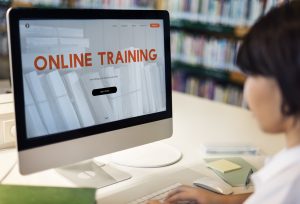Why did you become a teacher? A 2018 report from the University of Utah listed the top five factors that were very influential or extremely influential in the decision to become a teacher:
- Desire to make a worthwhile difference in the lives of children (85%)
- Desire to contribute to the greater societal good (70%)
- Experience working with children/young adults (64%)
- Sense of personal achievement (62%), and
- Subject matter interest or expertise (59%).
If you relate with these, you likely care about your teaching and want to provide a quality education for your students. However, with educators having the highest burnout rate among all industries in the United States, it’s easy to lose sight of why you wanted to teach in the first place, and difficult to retain connection with students.
We care about this problem, because students benefit from teachers that care. One 22 year-old student in Criminal Justice said:
There are some faculty members on this campus that will reach eye to eye to students. They won’t patronize them. They wouldn’t be like “oh you’re just a college student that wants this and that handed to them.” (…) There are professors that actually sit there and listen intently, not just listen and type on their computer while they’re doing something else. Those are the professors that I find, they have heart, is what I call it. They have that passion where they want to help students succeed. They’re not just there for a paycheck or just there for tenure or whatever it may be. (…) And they don’t care about oh you got this many assignments and on time whatever. It’s more about do you understand the concept? Do you really think critically about stuff?
How do you become a professor that listens? One that engages their students and makes an impact?
Our insights below come from our Insights on Student Feedback series on LinkedIn, and help you use student feedback to improve your teaching, not only helping the students but also helping you find meaning and joy in your teaching again.
This article contains three sections:
- Listening is a Teacher’s Most Powerful Tool
- #ThoughtsFromAnITStudent
- Using Student Evaluations to Help Students Learn
Listening Is a Teacher’s Most Powerful Tool
An op-ed in Education Week called listening “a teacher’s most powerful tool”. When teachers listen to and get to know their students, they have more power to impact and benefit them in a world where a host of information is readily available outside the classroom.
The writer of the op-ed reflects on how spending 5 minutes one-on-one with each student impacted her teaching, “We had together created a successful learning culture that represented and honored students as individuals, as well as gave them ways to connect.” While the writer is a 9th grade English teacher, the principle applies to any classroom: listening to your students improves your teaching.
Here are a few ideas to improve your teaching through listening to students. Which one would apply best to your classroom?
- Read virtual discussion boards, and respond to the posts of students
- Send individual emails
- Talk to students during and after classes
- Provide an avenue for anonymous feedback
- Give students a voice, and show them you are adapting based on their input
#ThoughtsFromAnITStudent
Hearing directly from students is a great way to find out what helps them learn. Recently, we talked to Utah Valley University IT student Trenton Howard, who shared that when professors listen to students, it makes all the difference:
“Having a good relationship with your professor can go a long ways,” says Trent. He highlights the impact of one professor, sharing, “One of my favorite professors sits down with each student twice a semester, either in person or virtually, to check in with them for 5-10 minutes. This was a great opportunity for me to feel like I could share what was working and what I wasn’t quite understanding.”

Reflecting on these meetings, Trent shares, “You could tell he prioritized his students and wants them to succeed.” He continues, “Meeting one-on-one with him, I felt like I could share more things that I was struggling with in class, things I probably wouldn’t have taken the time to share or get help on otherwise. I found myself telling other students to meet with him because he was so helpful, helping with classwork, finding internship opportunities and more.”
A quality education in IT has driven Trent’s passion for assisting others. “When it comes to IT, there’s a lot of people who need help with tech-related issues,” he says, “I’m the kind of person who loves helping people, and it’s cool to see when someone’s day gets better because I can help them.” Trent has always enjoyed technology and learning how things work, but chose to pursue IT as a career because of the potential for making an impact. Thanks to great teachers, he is already making an impact, working for Ascend Education as a technical support specialist and backend technician.
We shared highlights from this conversation with Trent in our latest IT Instructor Bytes newsletter. Check it out to read more tips for instructors.
Using Student Evaluations to Help Students Learn
Many colleges and universities have standardized student evaluations distributed each semester. In this section, we’ll share some strategies for making the most of these evaluations, then discuss a few limitations to be aware of.
IUPUI’s Center for Teaching and Learning highlights several strategies to use student evaluations to help students learn (https://lnkd.in/g6ukeKcC). Below are our favorites:
Demonstrate that You Care about Student Feedback
Communicate to students that you care about their academic progress, and show them changes that you’ve made over the years as a result of student evaluations. Conduct a mid-semester evaluation or student focus group and use the feedback to make adjustments for the second half of the semester. Both professors and students find this check-in helpful, and students are more likely to give constructive feedback because they can still benefit from any changes made during the remainder of the semester (https://lnkd.in/g55NeeaG).
Review Written Comments
Written comments tell more of the story than numeric scores, which are often given arbitrarily and without much thought. Pinpoint specific, repeated complaints, determine whether they are justified, and identify steps you can take to address that weakness. You can also use positive comments to determine what tactics you should continue using.
Determine What Changes You Will Make
Making changes to your teaching should be done to improve student experience, not simply to improve your ratings the next time around. That being said, there are a few tips you can apply based on your evaluation:
- To enhance teacher-student rapport, learn student names and communicate expectations clearly. Engage with students before and after class.
- Address low scores on organization by reviewing and aligning your course structure, syllabus, and objectives, and thoroughly preparing for lectures and activities.
- For low scores on instructor knowledge, integrate your personal research and content interests into class discussions and refine the presentation of your material.
Talk to a Consultant
Most institutions have a center for teaching and learning, or some staff dedicated to teacher development. Consultants in these areas can help you put your scores into perspective and sift through evaluations to determine what you might change to improve your teaching.
Overall, student evaluations can be a source of valuable insight, but it requires proper assessment by the professor. If your institution’s standardized evaluation isn’t particularly helpful, you may consider creating your own form of evaluation and having your students fill it out so you can obtain the feedback you need to improve your teaching.
Kristin Doerer’s 2019 article, “Colleges Are Getting Smarter About Student Evaluations. Here’s How.” highlights the limitations of student evaluations, especially when used in promotion-and-tenure decisions. Doerer highlights two primary drawbacks:
Bias
Historically, student evaluations tend to have gender and racial biases, a 2016 study finding that students’ teaching evaluations “measure students’ gender biases better than they measure the instructor’s teaching effectiveness.” They also found that more-effective instructors got lower ratings than others did.
Grade Inflation
A University of Oregon team cited in Doerer’s article found that students who took a prerequisite class from a professor with high student teaching evaluations did worse in the following course (everything else equal) than students who took the prerequisite course from a professor with lower evaluations.
Students tend to give high evaluation scores to easier professors, so professors have learned to “buy” better evaluations with easier grading. Doing so causes higher grades, but not necessarily a better learning environment.
Conclusion
Professors have the great privilege and responsibility of training and inspiring the next generation. While it is one of the most common occupations to burn out of, listening to students is one way to keep refining your craft, reminding yourself of why you’re a teacher, and making an impact.
If you’ve had an experience listening to your students that impacted your teaching, reach out to us: jslater@ascendeducation.com/old.






